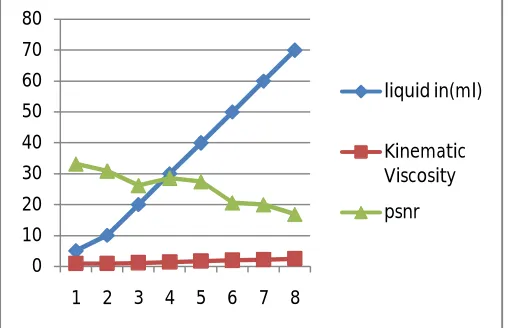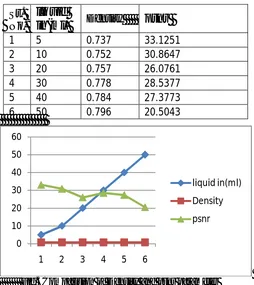ISSN(Online): 2320-9801
ISSN (Print): 2320-9798
I
nternational
J
ournal of
I
nnovative
R
esearch in
C
omputer
and
C
ommunication
E
ngineering
(An ISO 3297: 2007 Certified Organization)
Vol. 4, Issue 4, April 2016
Comparative Analysis of Fuel Adulteration
Methods
Pranjali P.Dharurkar1, Arti R.Wadhekar2
Assistant Professor, Dept .of E &C, Babasaheb Ambedkar Marathwada University, Aurangabad, India1 Assistant Professor, Dept. of E &C, Babasaheb Ambedkar Marathwada University, Aurangabad, India2
ABSTRACT:There are many problems faced by our country. Fuel adulteration is One of them Adulteration basically alters the original properties of fuel. For getting illegal profits these adulteration or mixing is done by the suppliers which will cause many of the problems like tail pipe emission, Air Pollution, Respiratory Disorders. Due to Physical Contamination to the fuels it doesn’t meet its original properties. Image Processing based system is consisting of statistical method in which various parameters psnr, MSE are calculated. And the Laboratory test based approach consists of parameters like Kinematic viscosity measurement; density based on sample test of the images. The Existing systems are quite tedious and time consuming. Kerosene and diesel are the common adulterants used in petrol. Fuel-adulterant mixtures in different proportions by volume were prepared and individually tested. The mixtures were administered to vehicles and the tail pipe exhaust emission drastically increased. The proposed system results are validated against Laboratory Tests. There is the change in the kinematic viscosity and density values.
KEYWORDS: -Adulteration, Kinematic Viscosity, Density
I.INTRODUCTION
Basically adulteration means physical contamination done to the fuel which will reduce the quality of fuel. Gasoline or Petroleum is considered to be one the important fuels so as to maintain the conveyance and transportation facilities. Better is the transportation better is the growth of the country. Formation of petroleum is done by various processing and then it is transformed into various forms. The formation of (CnH2n+1) gasoline is the combination of gases like Carbon and Hydrogen. The formation of gasoline consists of chemical combination of various gases like Hydrogen and Carbon combined with sulphur. Due to adulteration, many changes done in the properties and original characteristics. The petrol characteristics are changed in such a way that the product will affect the internal combustion of fuel. The fuel gives harmful pollutants in the atmosphere. Which in turn affect the internal combustion engines giving harmful pollutants in the atmosphere. Physical contamination basically causes overall change in the combination of fuel. Many of the substances like raffinate, slope, and naptha which are the soluble impurities due to which vehicles give harmful gases into the atmosphere. These changes in the formation of of fuel drastically increase the tailpipe emission problems. These adulterants damage the automobile engines and also lead to environmental pollution, Respiratory disorders like Asthma, Bronchitis, Lung Diseases. Many health issues are are caused due to harmful gases are given out through the tailpipe emissions of the vehicles.
II.LITERATURE REVIEW
The term "Adulteration" is usually used for the inclusion of unwanted substances. Due to price hike in the fuel and subsidized kerosene, adulteration is observed everywhere. Suppliers can have profit up to 10-15% by simply mixing the petrol with various substances. There are various approaches to define adulteration concentration, but the on field methods are very simple and raw methods like filter paper tests which has large scope of errors.
I]SIMULATION BASED FUEL ADULTERATION DETECTION APPROACH :-
ISSN(Online): 2320-9801
ISSN (Print): 2320-9798
I
nternational
J
ournal of
I
nnovative
R
esearch in
C
omputer
and
C
ommunication
E
ngineering
(An ISO 3297: 2007 Certified Organization)
Vol. 4, Issue 4, April 2016
values for AT &SC cut quartz crystal frequency responses which are helpful for displaying adulteration concentration percentage [1].
II]ADULTERATION DETECTION USING ARMCONTROLLER
:-S.D. Kale had proposed a hardware based technique for determination of adulteration concentration. Fuel adulation detection done by analyzing various parameters and quality determination is necessary. Small detection device is used to for the density test. Adulteration detection is done by determining comparing test results with standard reference using ARM controller which gives output on LCD. Various types of sensors are given as an input to the system controller through signal conditioning by which the output is displayed on LCD [2].
III]NONPOROUS SILICON MICRO CAVITY BASED FUEL ADULTERATION:-
An optical sensor had developed to detect the level of adulteration in a fuel sample using a porous given Fiber Optic Sensors are used determining adulterated concentrations of Petrol and diesel by Kerosene .The micro cavity, fabricated using electrochemical anodization process. The most commonly used adulterant kerosene was sensed by the micro cavity as an optical sensor for fuel adulteration was done. The sensor is reusable [3].
IV]FPGAIMPLEMENTATION OF DIPBASED ADULTERATION DETECTION :-
VLSI Implementation is done which makes use device design using Digital Color Imaging Principle. Various Sample Images are selected and they are compared with standard reference Image. All the sample Images are stored into Field Programmable Gate Arrays. FPGA based approach is helpful for high Speed comparison of Images and hardware Implementation [4].
V]FUEL ADULTERATION DETECTION SYSTEM :-
Author V. Jersha Felix has presented couple of methods All the three fuel types, Diesel, kerosene, Petrol are taken so as to carry out the heating operation of the sample. One of the constituent is evaporated and from the content remaining based on which adulteration decision can be given easily. Two Methods are compared of IR Detection and Image Processing based technique. Image Processing based method gives better result as compared to Hardware implentation of IR Detection [5].
VI]VLSIIMPLEMENTATION OF DIPBASED EDIBLE OIL ADULTERATION :-
G. Rajkumar has suggested one of the methods of VLSI implementation which makes use of Digital Image Processing so as to replace analogous sensors. Analogous sensor implementation is one of the the traditional method which time consuming. Castor oil is mixed with Edible oil which makes contaminates the edible oil. This Adulteration can be easily detected by the image processing analysis [6].
X]AN IMAGE PROCESSING AND NEURAL NETWORK BASED APPROACH FOR PLANT LEAF DISEASE DETECTION:-
This paper presents the colour based identification of plant leaf disease. The colour transformation principle is used by converting the images from RGB to gray [7]. Clustering algorithms are used for dividation of infected and main areas in the leaf. Based on that various parameters are calculated and validated through neural network .Features are used for identification of plant leaf detection[8].
III. SYSTEM DEVELOPMENT
ISSN(Online): 2320-9801
ISSN (Print): 2320-9798
I
nternational
J
ournal of
I
nnovative
R
esearch in
C
omputer
and
C
ommunication
E
ngineering
(An ISO 3297: 2007 Certified Organization)
Vol. 4, Issue 4, April 2016
The proposed system consists of:-
The proposed system consists of simple set up. High Resolution camera is used to capture the images. The images are stored into the database. Experimental Set up comprises of white LED Strips so as to avoid the problems of Reflection and Refraction pattern generation in the images. Glass Cube is taken for individual testing of sample, then interfaced with PC and then parameters are calculated through MATLAB software.
PREPARATION OF CUSTOM PROPORTIONS MIXTURE OF FUEL AND ADULTERANT:-
Two adulterants used and custom proportions of the liquids are made. Diesel is mixed in volume by different proportions:
(195:5,190:10,180:20,170:30,160:40,150:50) PARAMETER CALCULATION:-
With different proportions of kerosene and diesel the images are captured and various parameters are calculated first and then the resulting outputs are seen in terms of psnr parameters.
COMPARATIVE ANALYSIS OF STATISTICAL METHOD AND LABORATORY TEST BASED METHOD
:-Laboratory tests are conducted for both the impurities of Diesel and Kerosene. Features are used for identification of plant leaf detection.
Table1Comparision of Kinematic Viscosity and psnr for Kerosene
Sr.
No.
liquid
in (ml)
Kinematic
Viscosity
[Laboratory
Test Based]
psnr
[Statistical
Method]
1 5 0.9376 33.1251
2 10 0.9669 30.8647
3 20 1.1427 26.0761
4 30 1.4064 28.5377
5 40 1.6701 27.3773
6 50 1.9338 20.5043
Comparison of Laboratory test based parameters is done with Statistical parameters. Liquid(Impurity in ml) is taken by which Kinematic Viscosity is measured then compared with peak signal to noise ratio.
Fig. 3.2Graph showing Percentage of Impurity, Density and psnr parameter
Different proportions of liquids are taken for the tests and then various parameters are measured like Kinematic Viscosity, Density and they are compared with the psnr(Image based statistics) parameters which gives the result as pure or impure
.
0 10 20 30 40 50 60 70 80
1 2 3 4 5 6 7 8
liquid in(ml)
Kinematic Viscosity
ISSN(Online): 2320-9801
ISSN (Print): 2320-9798
I
nternational
J
ournal of
I
nnovative
R
esearch in
C
omputer
and
C
ommunication
E
ngineering
(An ISO 3297: 2007 Certified Organization)
Vol. 4, Issue 4, April 2016
Table 2Comparision of Density and psnr for kerosene
Fig.3Comparision of Density and psnr parameter
Table gives the idea and comparison of Density and psnr,basically psnr goes on decreasing however there are smaller changes in Density values.
IV. PERFORMANCE ANALYSIS
The kinematic viscosity goes on increasing as impurity percentage increased. However Density also shows same changes as impurity percentage is added into the fuel.The Laboratory test based results are compared with statistics of the images. Psnr is basically peak signal to noise ratio. This function computes the degradation.Basically, psnr factor determines the quality of image, the signal to noise ratio. The ratio of psnr is often used as a quality measurement between the original and a compressed image. Higher the PSNR better is the quality of the compressed or reconstructed image. PSNR gives better result than that of Laboratory tests based approach.
V. CONCLUSION & FUTURE SCOPE
The proposed system is easy to implement and has higher efficiency. Fuel adulteration causes Air Pollution, Respiratory disorders, Damage to the vehicles, Tailpipe Emission. with the implementation of the system these can be reduced up to greater extent which will be helpful and beneficial for the society. Two different methods are compared like Laboratory Test based approach and Image Processing based Statiscal Approach. Image Processing based system gives better results than that of Laboratory tests. There is need of research in the area of Image Processing algorithms which are used for identification of adulteration concentrations.
REFERENCES
[1]Ranjan Dey,Anumeha Dwivedi-Journal of Energy and Chemical Engineering-Design and Simulation of Portable Fuel Adulteration Detection Kit,Apr.2014,Vol.Iss.2,PP.74-80
0 10 20 30 40 50 60
1 2 3 4 5 6
liquid in(ml)
Density
psnr
Sr. No.
liquid
in(ml)
Densitypsnr
1 5 0.737 33.1251
2 10 0.752 30.8647
3 20 0.757 26.0761
4 30 0.778 28.5377
5 40 0.784 27.3773
ISSN(Online): 2320-9801
ISSN (Print): 2320-9798
I
nternational
J
ournal of
I
nnovative
R
esearch in
C
omputer
and
C
ommunication
E
ngineering
(An ISO 3297: 2007 Certified Organization)
Vol. 4, Issue 4, April 2016
[2]Prof. S.D. Kale, Anchawale Prasad, Gaikwad Milind, Gawade Prakash, Karhale Nishant, International Journal of Advanced Research in Electronics and Communication Engineering (IJARECE) Volume 4, Issue 1, January 2015
[3]Vivekanand Mishra Vidushi Tiwari P.N. Patel- Nanoporous Silicon Microcavity Based Fuel Adulteration Sensor, Silicon DOI 10.1007/s12633-015-9311-x
[4] G.Rajakumar,--FPGA Implementation of Dip based Adulteration Identification in Food Samples International Journal of Computer Applications (0975 – 8887) Volume 35– No.1, December 2011
[5]V. Jersha Felix1*, Purohitam Adithya Udaykiran1 and K.Ganesan2-Fuel Adulteration Detection System, Indian Journal of Science and Technology, Vol 8(S2), 90-95, January 2015
[6]Sergey V. Smirnov- Melamine Analysis in Liquid Milk by Simple and Robust Neural Network Based Method, I.J. Education and Management Engineering 2011, 3, 24-30
[7]Dr.D.manimegalai-VLSI Implementation of DIP based Edible oil Adulteration Identification,Volume 3,Issue 5,May 2013

